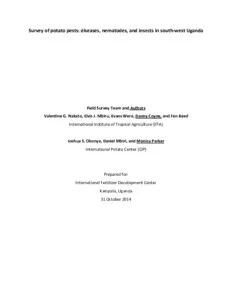Survey of potato pests: diseases, nematodes, and insects in south-west Uganda. Report prepared for the International Fertilizer Development Center

Abstract
A survey of diseases, nematodes, and insect pests affecting seed potato production was carried out in the Kabale and Kisoro districts of south-western Uganda in March and June 2014. The objective was to identify areas suitable for seed potato production in south-western Uganda having low disease and nematode pressure and prevalence; in relation to this, pests and diseases were identified from various potato farms in south-western Uganda. Potato virus Y (PVY) was detected from farms in Kabale and associated with an altitude gradient, with greater incidence observed at the lowest altitude range (1,700–1,900 masl). Potato leafroll virus (PLRV) was diagnosed from farms in both Kabale and Kisoro but seemingly was unrelated to altitude. PVY and PLRV are the principal viruses affecting seed quality. Bacterial wilt (BW) was observed and detected in both districts, but to a lesser extent in Kisoro, without any clear effect of altitude range. Pathogenic plant parasitic nematodes (Meloidogyne spp., Pratylenchus spp., and Ditylenchus spp.) were isolated from soil and potato tubers to a similar extent, with the former detected at a greater rate, in both districts. Meloidogyne spp. were most prevalent, however, occurring in almost 100% of fields visited. Potato tuber moth damage was observed in both districts. In summary, the higher elevation regions in Kisoro district, which frequently border Kabale district, are more preferable for seed potato production due to less overall observed and diagnosed incidences of the major seed-borne biotic threats—notably BW, PVY, and nematodes.
